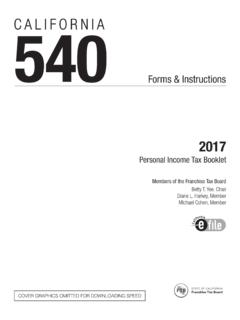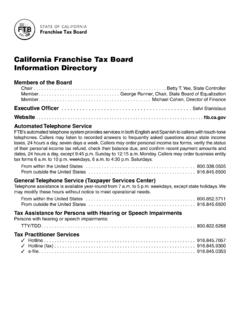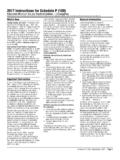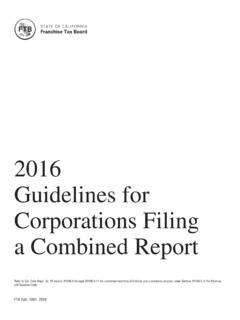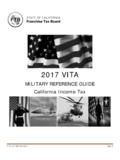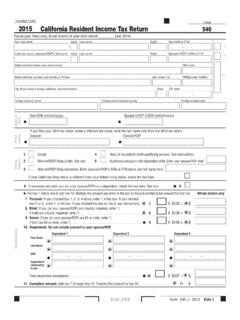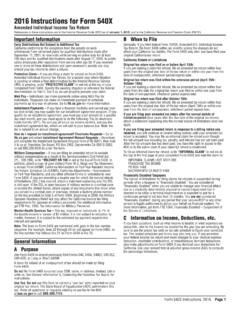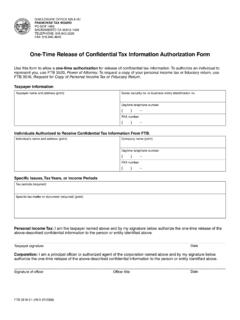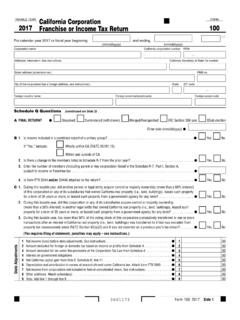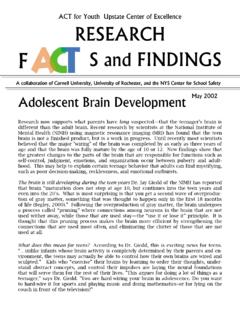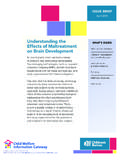Transcription of FTB 1082, Research & Development Credit: …
1 Research & Development Credit: Frequently Asked QuestionsCalifornia Franchise Tax Board QUALIFIED R&D ACTIVITY 1. What is California's Research & Development (R&D) Credit? 2. How do you claim the California R&D Credit? 3. Does California conform to federal R&D Credit provisions? 4. What is "qualified Research " for California's R&D Credit? 5. What Research activities do not qualify for California's R&D Credit? R&D COMPUTATION 6. What are "qualified Research expenses" (QRE) for California's R&D Credit? 7. What are "basic Research payments" for California's R&D Credit? 8.
2 How are gross receipts defined for California purposes? 9. What are the aggregation rules? 10. How are a controlled group and/or "controlled trades & businesses" defined for California's R&D Credit? 11. Is the controlled group for R&D Credit aggregation purposes the same as a unitary group for combined reporting purposes? 12. Is the controlled group restricted to entities either currently or historically conducting Research ? 13. What is a start-up company for California R&D Credit purposes? DOCUMENTATION REQUIREMENTS 14. Is there a documentation requirement? 15. What are the specific documentation requirements for the California R&D Credit?
3 16. Are we required to provide contemporaneous support? 17. Can we use estimates? 18. What is sufficient documentation? 19. What documents will FTB typically rely upon? 20. How should we document our Research and expenditures when our company is small, organizationally flat, and not in a highly regulated industry? MISCELLANEOUS 21. How does the inclusion of a partnership affect the R&D Credit? 22. How does the acquisition or disposition of a business entity affect the California R&D Credit computation? 23. Does the R&D Credit have to be added back into income as a California state adjustment?
4 24. Do we need FTB permission to change our election reducing our Research and Development expenses by the amount of credit, rather than applying the applicable reduced credit percentage to the credit? 25. Can the credit reduce alternative minimum tax? 26. Can we amend a prior year return to claim a qualified R&D Credit? 27. Is California's R&D Credit a refundable credit? 1. What is California's Research & Development (R&D) Credit? The California R&D Credit reduces income or franchise tax. You qualify for the credit if you paid or incurred qualified Research expenses while conducting qualified Research in California.
5 You receive 15 percent of the excess of current year Research expenditures over a computed base amount (minimum of 50 percent of current year Research expenses). You claim the credit on the return for the taxable year you incurred the qualified expenses. 2. How do you claim the California R&D Credit? You claim the California R&D Credit on FTB Form 3523, Research Credit, for the year you paid or incurred qualified Research and Development expenses in California. 3. Does California conform to federal R&D Credit provisions? California law generally conforms to the federal Research credit as enacted under the Small Business Job Protection Act of 1996.
6 However, California does make some modifications. The more common modifications are: 1. The definition of qualified organization includes hospitals run by public universities and certain cancer centers. 2. Basic Research and qualified Research must be conducted in California to qualify. 3. For taxable years beginning on or after 1/1/2000, the credit is 15 percent of qualified Research expenses for all taxpayers. In addition, corporations (other than S Corporations, personal holding companies, and service organizations) may be eligible for the basic Research credit, which is equal to 24 percent of the excess of basic Research payments paid or incurred during the year over the base period amount.
7 The basic Research rate is 24 percent. 4. California conformed to the Alternative Incremental Credit, except for some differences in the rates and the fact that California requires a separate election (from that of federal). For taxable years beginning on or after 1/1/2000, the percentages for the Alternative Incremental Credit are percent, percent, and percent. 5. California has not conformed to the 2006 federal amendments to IRC 41. Thus, the Alternative Simplified Credit is not available. 6. The credit cannot be carried back. 7. California does not conform to the federal definition of gross receipts.
8 8. The termination dates provided under federal law do not apply. Currently, there is no California termination date for this credit. 4. What is "qualified Research " for California's R&D Credit? Research activity is considered qualified Research if it meets all of the following four requirements of Internal Revenue Code (IRC) 41(d)(1): 1. Qualify as a business deduction under IRC 174. 2. Be undertaken to discover information that is technological in nature. 3. Be undertaken to discover information intended to be useful to develop a new or improved business component of the taxpayer. 4.
9 Substantially all activities involve a process of experimentation. "Substantially all" means 80 percent or more of the Research activities involve a process of experimentation. A qualified Research activity must meet all four tests to be considered for the California R&D Credit. Apply the tests separately to each business component of the taxpayer. 5. What Research activities do not qualify for California's R&D Credit? The following Research activities are specifically excluded by statute: 1. Research undertaken outside California. 2. Research conducted in the social sciences, arts, or humanities.
10 3. Ordinary testing or inspection of materials or products for quality control. 4. Market and consumer Research . 5. Research relating to style, taste, cosmetic, or seasonal design. 6. Advertising and promotional expenses. 7. Management studies and efficiency surveys. 8. Computer software for internal use of the taxpayer, unless it meets additional tests. 9. Research to locate and evaluate mineral deposits, including oil and gas. 10. Acquisition and improvement of land and of certain depreciable or depletable property used in Research (including the annual depreciation deduction).
